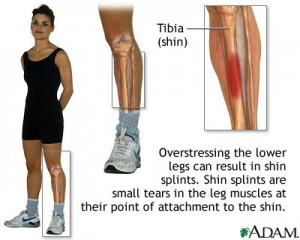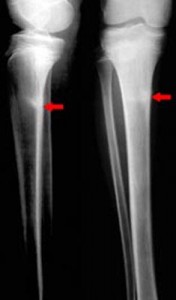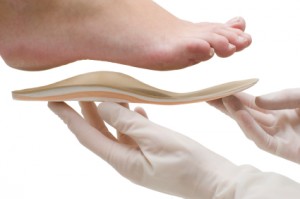Symptoms of Shin Splints:
- Tenderness, soreness or pain along the inner part of your lower leg

- Mild swelling in your lower leg
Shin splints typically only cause pain when running or exercising in the beginning, but may progress to cause continuous pain. If the pain does not reside with rest, ice and over-the-counter pain relievers, see your doctor.
Cause:
Repetitive stress on the shinbone and the tissues that connect your muscles to the bone from exercises like running, jumping, or dancing can cause shin splints.
Risk Factors:
- Running frequently, especially just beginning a running program
- Sports on hard surfaces, especially with sudden stops and starts
- Running on uneven terrain, such as hills
- Military training
- Flat feet or high arches
Tests and Diagnosis:
Shin splints can usually be diagnosed based on your medical history and a physical exam. You may also need X-rays or bone scans to look for stress fractures.
Treatment:
Typically, shin splints can be treated at home very simply. Just do the following:
- Rest. Avoid activities that cause pain, swelling or discomfort — but don’t give up all physical activity. While you’re healing, try low-impact exercises, such as swimming, bicycling or water running.
- Ice. Apply ice packs to the affected shin for 15 to 20 minutes at a time, four to eight times a day for several days. To protect your skin, wrap the ice packs in a thin towel.
- Over-the-counter pain relievers. Try ibuprofen (Advil, Motrin IB, others), naproxen sodium (Aleve) or acetaminophen (Tylenol, others) to reduce pain.
Resume your usual activities gradually. If your shin isn’t completely healed, returning to your usual activities may cause continued pain.
Prevention:
- Shoes. Wear footwear that suits your sport. If you’re a runner, replace your shoes about every 350 to 500 miles (560 to 800 kilometers).
- Arch supports. Arch saupports can help prevent the pain of shin splints, especially if you have flat arches.
- Less impact. Cross-train with a sport that places less impact on your shins, such as swimming, walking or biking. Remember to start new activities slowly. Increase time and intensity gradually.
- Strength training. To strengthen your calf muscles, try toe raises. Stand up. Slowly rise up on your toes, then slowly lower your heels to the floor. Repeat 10 times. When this becomes easy, do the exercise holding progressively heavier weights. Leg presses and other exercises for your lower legs can be helpful, too.
H/T MayoClinic.org






